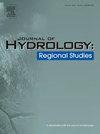Climate change dominates historical runoff variations at multiple time scales in typical agricultural basin of South China
IF 4.7
2区 地球科学
Q1 WATER RESOURCES
引用次数: 0
Abstract
Study region
The Hanjiang River Basin (HRB) in South China
Study focus
The attribution identification of runoff variation is conducive to formulating climate change response strategies to cope with regional water resources problems. At present, the specific driving mechanisms of seasonal-scale runoff variation require further exploration and research. This study employs five runoff attribution methods, including linear regression, two hydrological models, and two elasticity methods, to quantitatively dissect the influences of climate change and human activities on runoff variation during 1960–2016 in the HRB.
New hydrological insights for the region
The abrupt change detection results indicate that 1972 is the abrupt change point of the runoff series in the HRB. The series is split into two periods: 1960–1972 (baseline period with limited anthropogenic influence) and 1973–2016 (change period). The average results from different methods unequivocally attribute the leading causes of runoff variation to climate change (43.92–135.01 mm), with human activities contributing less (−19.15–36.78 mm). Human activities are observed to partly offset the impact of climate change on runoff variation by approximately 1.3–28.4 %. Results from different methods show similar patterns, with smaller differences in the flood season than the non-flood season. The multi-method approach employed in this study provides valuable insights for policymakers and water resource planners seeking to address the complex interplay of climate change and human activities.
气候变化主导着华南典型农业流域多时间尺度径流的历史变化
研究区域汉江流域径流变化的归因识别有助于制定应对区域水资源问题的气候变化应对策略。目前,季节尺度径流变化的具体驱动机制还需要进一步探索和研究。本文采用线性回归、两种水文模型和两种弹性模型等5种径流归因方法,定量分析了1960-2016年气候变化和人类活动对青藏高原径流变化的影响。突变探测结果表明,1972年是青藏高原径流序列的突变点。该系列分为两个时期:1960-1972年(人为影响有限的基线期)和1973-2016年(变化期)。不同方法的平均结果明确地将径流变化的主要原因归因于气候变化(43.92 ~ 135.01 mm),人类活动的贡献较小(−19.15 ~ 36.78 mm)。观测到,人类活动在一定程度上抵消了气候变化对径流变化的影响,抵消幅度约为1.3 - 28.4% %。不同方法的结果相似,汛期差异小于非汛期差异。本研究采用的多方法方法为决策者和水资源规划者寻求解决气候变化和人类活动之间复杂的相互作用提供了有价值的见解。
本文章由计算机程序翻译,如有差异,请以英文原文为准。
求助全文
约1分钟内获得全文
求助全文
来源期刊

Journal of Hydrology-Regional Studies
Earth and Planetary Sciences-Earth and Planetary Sciences (miscellaneous)
CiteScore
6.70
自引率
8.50%
发文量
284
审稿时长
60 days
期刊介绍:
Journal of Hydrology: Regional Studies publishes original research papers enhancing the science of hydrology and aiming at region-specific problems, past and future conditions, analysis, review and solutions. The journal particularly welcomes research papers that deliver new insights into region-specific hydrological processes and responses to changing conditions, as well as contributions that incorporate interdisciplinarity and translational science.
 求助内容:
求助内容: 应助结果提醒方式:
应助结果提醒方式:


